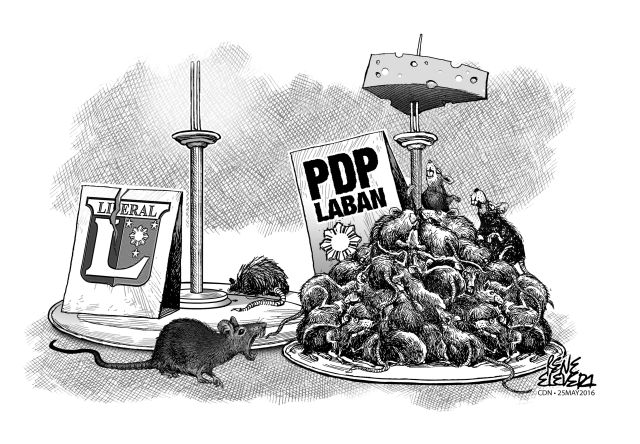
Amid reports that Congress is supposedly scheduled to proclaim presumptive President Rodrigo Duterte as the country’s 16th president today, the exodus of Liberal Party (LP) members into the fold of the PDP-Laban is to be expected since it has sadly become a part of the political landscape.
In fact the movement away from the LP had become the norm even before the May 9 elections with some proclaiming their support to either Sen. Grace Poe or Duterte. Now that Duterte has become the clear majority winner the transfer of politicians and re-elected and newbie officials will continue unabated until perhaps only a few remain in the LP fold.
As Duterte himself said, he is the chief disbursing officer and the lawmakers and local officials, even those with strong domestic parties, go where the money flows. Besides, Filipino voters are a fickle lot because they vote based on their perception of a candidate’s personality and strengths rather than his or her platform.
Which is why proposals for a two-party rather than a multi-party system may only be relegated to the dustbin due to the tendency of politicians to follow those holding the money bags. And when the chief disbursing officer has a strong successor the chances are good that they will still retain power for a good many years until the Filipinos decide to choose another.
A multi-party system, while offering a host of choices for Filipinos often results in a divisive election especially if the candidates fielded have strong showings. Duterte, while having a large winning margin, clearly wasn’t the only candidate in history to have won decisively.
But then again we base that on the 1992 elections in which then president Fidel V. Ramos narrowly defeated then immigration chief Miriam Defensor-Santiago to win. Though former president Joseph Estrada, President Benigno Aquino III and now Duterte have won in convincing fashion, the likelihood of a majority vote in a field of five to more candidates remains iffy at best.
Still, proponents of a two-party system floated the rather curious requirement of taxpayers having to fund these two parties for them to field candidates and otherwise sustain their operations. One has to verify if a similar arrangement is done in the US which has an existing two party system or in some parts of Europe where a presidential system is in place.
We have to ask if it is fair that taxpayers had to pay for a two-party system rather than these politicians source out their funds through smaller, even local parties in order to allow more politicians from the regional level to participate in conventions that will whittle down and even allow the selection of candidates other than those in Luzon and the Visayas.
Again, a two party system is just about as feasible as that proposal to federalize the Philippines which proponents like former Sen. Aquilino Pimentel, Jr. said would take as long as two years but which Duterte insists can be done in a matter of weeks. Change may be coming but it won’t likely happen overnight.